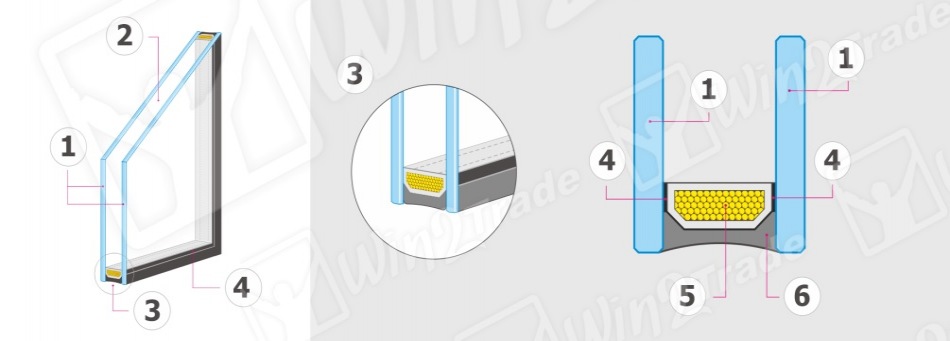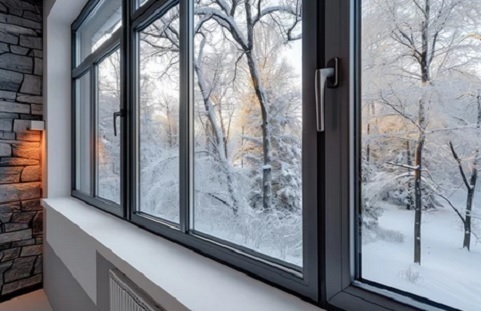What are insulated glass units and what are their applications?
Insulated glass units, also known as thermo-insulating glass, are commonly used in windows. They consist of two or more glass panes separated by a space filled with gas. The basic components of an insulated glass unit are the glass panes, the inter-pane space, the spacer bar, seals, and desiccants.
Glass panes are single or laminated glass sheets that form the outer layers of the insulated glass unit. Their thickness depends on the requirements for thermal and acoustic insulation. The inter-pane space, which separates these panes, is filled with gas (most commonly argon) or a vacuum, improving thermal insulation.
The spacer bar is a metal or plastic profile that maintains the proper distance between the glass panes, adds rigidity and stability to the structure, and can enhance thermal insulation if made from materials with low thermal conductivity (known as warm-edge spacers). These spacers often contain desiccants, typically silica gel, which prevent condensation inside the glass unit by absorbing moisture.
Seals, usually made of butyl, prevent air, moisture, and contaminants from entering the inter-pane space, providing flexibility and durability to the connections between the glass panes.
Insulated glass units can be tailored to different needs, such as thermal and acoustic insulation, protection from solar radiation, privacy (with frosted or patterned glass), and safety. Butyl, used as a sealant, is highly resistant to atmospheric factors, UV radiation, and temperature.
Thermal bridges, areas with higher heat conduction, can reduce the thermal insulation of the insulated glass unit, especially where the spacer bar contacts the glass panes. To minimize their impact, manufacturers often use spacers made from materials with low thermal conductivity.
Condensation can occur on the surface of the spacer if it is cooler than the surrounding air. To avoid this, proper ventilation of the rooms, maintaining appropriate relative humidity, and good thermal insulation of the entire window structure are recommended. The dew point, the temperature at which water vapor in the air condenses, depends on the relative humidity of the air; the higher the humidity, the higher the dew point.
Ensuring proper design and selection of insulated glass units with minimal risk of condensation, along with the use of appropriate insulating materials and ventilation, is crucial for the durability and efficiency of thermo-insulating windows.
Description of the upper image:
1. glass pane 2. inter-pane space 3. spacer bar 4. butyl seal 5. molecular sieve (desiccant) 6. sealant
- Economy
- Export
- International cooperation
- Construction sector - Joinery, engineering and building architecture
- Agriculture, Food
- Regional development, investment in Poland
- What's worth knowing
Construction sector - Joinery, engineering and building architecture
What are insulated glass units and what are their applications?

Source: https://win2trade.com/en

See also:

Chocolate and chocolate products from Poland
For years, Poland has been strengthening its position as one of the key exporters of chocolate products in Europe. Chocolate exports constitute an important segment of Polish foreign trade and cover a wide range of chocolate products

Cherry Export. Polish Cherries Around the World
The export of cherries from Poland is playing an increasingly important role in the international fruit market.

Cosmetics export. Cosmetics from Poland
The export of cosmetics and toiletries from Poland is developing at a dynamic pace, thanks to which Poland has gained the status of one of the leaders in the production and sale of these products in Central and Eastern Europe

Export of Windows: Window Joinery from Poland
Poland has been playing an important role on the international window market for many years, being one of the largest window exporters in the world.

FTA - Free Trade Agreements: Do They Exist and Can They Lower Tariffs?
Free Trade Agreements (FTAs) are key tools in international trade policy, aimed at reducing trade barriers...
Help needed ?
If you have not found the desired product, company, service or the searching results are not satisfactory for you, do not hesitate to contact us and tell what you are looking for or what you need. We will send your inquiry directly to the interested companies.
Write to us

 pl
pl  en
en  de
de  es
es  fr
fr  it
it  pt
pt  ru
ru  sv
sv 













.jpg)


